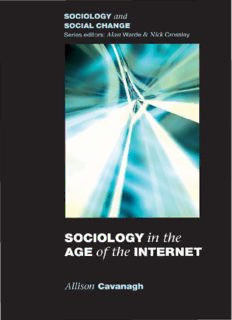
Sociology in the Age of the Internet (Sociology and Social Change) PDF
Preview Sociology in the Age of the Internet (Sociology and Social Change)
SOCIOLOGY IN THE AGE OF THE INTERNET SOCIOLOGY IN THE AGE OF THE INTERNET Allison Cavanagh • Open University Press Open University Press McGraw-Hill Education McGraw-Hill House Shoppenhangers Road Maidenhead Berkshire England SL62QL email: [email protected] world wide web: www.openup.co.uk and Two Penn Plaza, New York, NY 10121-2289, USA First published 2007 Copyright © Allison Cavanagh 2007 All rights reserved. Except for the quotation of short passages for the purpose of criticism and review, no part of this publication may be reproduced, stored in a retrieval system, or transmitted, in any form or by any means, electronic, mechanical, photocopying, recording or otherwise, without the prior written permission of the publisher or a licence from the Copyright Licensing Agency Limited. Details of such licences (for reprographic reproduction) may be obtained from the Copyright Licensing Agency Ltd of Saffron House, 6-10 Kirby Street, London, EC1N 8TS. A catalogue record of this book is available from the British Library ISBN-13: 9780335217250 (pb) 9780335217267 (hb) ISBN-lO: 0335217257 (pb) 0335217265 (hb) Typeset by BookEns Limited, Royston, Herts. Printed in Printed in Poland by Oz Graf S.A. www.polskabook.pl The McGraw'HiII Companies Contents Series editor's preface vi Acknowledgements viii Introduction 1 Part One The rise of the network metaphor 1 Approaches to networks 23 2 Network methodologies 27 3 The network society 38 4 The internet as a network 48 Part Two The internet as a medium Introduction to Part Two 5 Elements of a public sphere 64 6 Interactivity: it's got to be jelly 'cos jam don't 81 shake like that 7 The global public sphere and forms of power 92 Part Three The internet as a social space Introduction to Part Three 8 Community 102 9 Online identity 120 Conclusion to Part Three 132 Part Four The internet as a technology Introduction to Part Four 10 Sociologies of technology 139 11 The sociology of technology and the internet: 151 emergent perspectives References 164 Index 00 To my mother, with all my love. Series editor's preface In response to perceived major transformations, social theorists have offered forceful, appealing, but contrasting accounts of the predicament of contemporary western societies and the implications for social life and personal well-being. The speculative and general theses proposed by social theorists must be subject to evaluation in the light of the best available evidence if they are to serve as guides to understanding and modifying social arrangements. The focus of the series is the critical appraisal of general, substantive theories through examination of their applicability to different institutional areas of contemporary societies. Each book introduces key current debates and surveys of existing sociological argument and research about institutional complexes in advanced societies. Allison Cavanagh's book addresses a technological innovation whose impact upon societies has been enormous and which looks sets to continue: the internet. The book is divided into four parts, which discuss the internet, respectively, as a network, as a form of (communication) media, as a social space and as a technology. This neat division allows the author to explore, in detail, the multidimensional nature of the internet and its impact, as well as the quite diverse debates that it has sparked. The result is a fascinating discussion, which serves both to introduce newcomers to this exciting field of investigation and to carve out a persuasive position within it. Allison Cavanagh opens her account with the claim that 'Studies of the internet often become obsolete between writing and publication.' This is surely true, at one level, given the pace of change in both the technology and the uses that social actors find for it. Analytic frameworks, if solid and insightful, however, do not and need not change at quite the same pace. They have the potential for enduring significance. We believe that Sociology in the Age of the Internet has this potential and will remain a central point of reference in both research and teaching for many years to come. Acknowledgements With grateful thanks to Nick Crossley, who inspired this book in the first place and whose advice on earlier drafts has improved the work immeasur ably. Staff at the Institute of Communications Studies (ICS), University of Leeds, encouraged me in writing this and supported a period of study leave. I should particularly like to thank Robin Brown for helping me to reorganize my commitments and stepping into the breach himself to allow me to complete the work on it. Paul Taylor, Katherine Sarakakis and Richard Howells have helped me keep my spirits up, and Steve Lax particularly helped me ground and clarify my ideas around technology. I should also like to thank students taking my first-year course at ICS, who were supportive and generous with their feedback when I road-tested these materials with them, and who have helped me to keep my enthusiasm for the project alive throughout. Any bloopers are, of course, my own. SpeCial thanks are due to Mark Barrett and Chris Cudmore at McGraw-Hill for their support and encouragement. Thanks also to Dr Maria Touri, who kept me on track by threatening to read it. My mother and my sister, Amanda, have listened, consoled, helped me stay focused, and brought me down to earth when some of my wilder ideas were on their annual migration. Finally, a special debt of gratitude to Alex Dennis, my long-suffering partner, for sitting through the umpteenth 'going on' of the day with saintly patience, offering his considerable expertise in leading me out of a myriad of blind alleys, and whose insights often turned the work in new, and better, directions. Without Alex, no book.
Description: